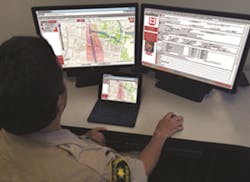Mission Manager Inc. has released a dynamic upgrade to its NIMS ICS forms that will greatly improve the efficiency of an agency’s reporting process. Mission Manager’s pre-filled forms are now editable, which enable incident commanders/emergency managers to customize reports needed for legal compliance, government reimbursements and debriefs.
Cloud-based Mission Manager, which is based on preparation, readiness and execution, provides an operational environment for daily team management and also serves as an online command center. It is a “one-stop shop” solution for team and asset management, mission planning and execution — all of which lay the foundation for a strong infrastructure needed to save lives and property.
Mission Manager’s automated reporting function is a powerful feature of the incident management software tool. Its robust database auto-populates certain fields in the forms, based on mission events — whether the mission involves a large-scale disaster, search-and-rescue operation, training exercise or planned event. The forms are fully compliant with the National Incident Management System (NIMS) Incident Command System (ICS).
The editable feature is available on the most commonly used pre-filled ICS forms, including Incident Briefing, Assignment List, Incident Check-In List, Incident Radio Communications Plan, Medical Plan and Activity Log.
“We are very excited to release the enhanced forms to Mission Manager’s user community. With the editable feature, administrators can produce their reports faster and smarter with a click of a button. This reduces unnecessary paperwork and overtime often required to get reports done on time,” said Michael J. Berthelot, president and CEO of Mission Manager Inc.
When used as a daily tool, Mission Manager allows incident commanders to manage everything from attendance records, training and missions to issued weapons and equipment. It also consolidates functions such as document management, timekeeping, scheduling and task management. Because these functions ensure teams are prepared — long before a crisis begins — incident managers can quickly deploy the right people at the right time.
Execution of the mission is initiated with simple drag-and-drop team-building. Incident commanders can easily create missions with pre-set or customized checklists. They can also quickly callout members via SMS text, email or voice (or all three simultaneously).
In the field, Mission Manager provides a common operational picture across multiple devices, including laptops, smart phones and tablets. Situational awareness is enhanced with robust maps featuring more than 100 mapping layers.
All phases of an event are tracked in real time, including team locations, event/radio logs and assignment status. Every activity is automatically logged and recorded, providing a second-by-second record of every mission and event. This information can be easily exported as NIMS ICS reports.
Mission Manager helps ensure a unified command, enabling incident commanders to obtain, share and manage critical information. During an incident, Mission Manager provides a user-defined Common Operational Picture that can be shared with agencies providing mutual aid. Mission Manager can easily scale to thousands of users as needed, including spontaneous volunteers.




